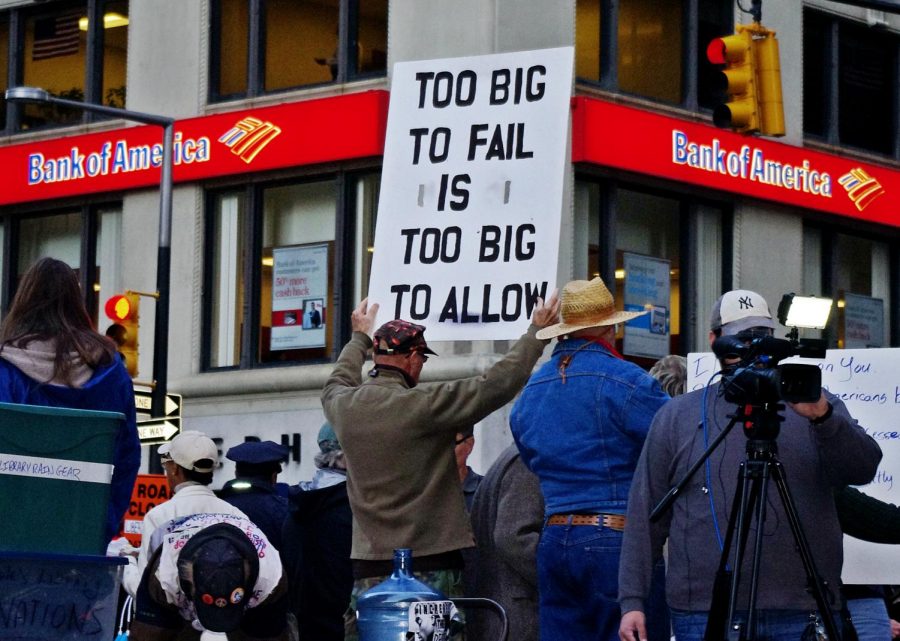Opinion | Big bank bailout more nuanced than perceived
Photo Courtesy of David Shankbone
A demonstrator holds his sign high during an Occupy Wall Street protest on Oct. 25, 2011. Columnist Austin argues more needs to be done to educate the public on these “bailouts.”
March 5, 2020
Since 2008, the term “bailout” has been popularized by politicians across the left as a result of the federal government having to step in and provide over $600 billion to banks, mortgage corporations, automobile companies and other programs that would provide relief to the economic fallout of the great recession.
But is it correct to assess that the Troubled Asset Relief Program (TARP), signed by President Bush in late 2008, was simply a bailout of the corrupt financial institutions that created the crisis? Not exactly.
While the TARP undoubtedly did bail out the financial institutions and auto companies that were weeks away from completely collapsing, the specifics of the program are more complex.
When the government, via the Treasury, bought bad assets and stock from failing companies to keep them afloat, it required the banks to take on a 5% dividend they would pay to the government, that would go up to 9% in 2013, so the government would be guaranteed to make a profit from their loans to the banks.
Banks don’t like paying out money, so the rising interest rate was to incentivize the big banks to buy back all the stock within five years, when the economy would ideally return to normal functionality.
Get The Daily Illini in your inbox!
What all this means is that the government didn’t just give the banks a lump sum of money with no strings attached, but rather they gave them carefully crafted loans under conditions that were favorable for the government to make extra money back from the loans given.
While the Treasury had a total outflow balance (money that was spent, invested or loaned) of $633.6 billion, the total inflow balance (money returned and paid to the Treasury as interest, dividends, fees or to repurchase their stock) has so far totaled $754.8 billion — netting a $121.2 billion in profit for the government. All the specific data and exact payments can be found on ProPublica’s “Bailout Tracker.”
This doesn’t mean that the big banks don’t deserve all the scrutiny for enabling the crisis, they most certainly do, but rather it brings attention to how the actual functionality of the government’s handling of the crisis was much more nuanced than simply bailing out the people who caused it.
More valid criticisms of the handling of the TARP should be in the vein of the government not doing enough for the normal working people who felt the effects the hardest.
While the TARP did establish programs to help people with bad mortgages through the Homeowner Affordability and Stability Plan, it set aside only $75 billion and essentially let the banks decide who would qualify for reduced or refinanced payments. The same banks that were recklessly giving out loans to anyone prior to the crash were now being selective in who would or would not potentially have their home foreclosed on.
Overall, the decision to bail out the financial institutions and auto industry remains regarded as the right decision by a vast majority of economists. Upward of a couple million auto jobs were saved, five million homes were prevented from foreclosing and the banking industry quickly turned around in order to stabilize the economy less than a year after the initial fallout.
What an actual bailout looks like, albeit on a much smaller scale, is the current status of President Trump’s trade war with China and its effects on the nation’s farmers.
When factoring in all the costs and loans repaid from the auto bailout alone, taxpayers footed a mere $12 billion to save the aforementioned millions of jobs and livelihoods of future generations. Currently, taxpayers are footing a $28 billion bill in payments to farmers, predominantly to larger and wealthier farms, with no repayments to be made.
The discussion on “bailouts” often misses the point. The response to the financial crisis has very valid criticisms, but they are in the areas of how the average American was helped during the crisis and the moral hazard that bailing out the banks could create if they aren’t properly regulated, not in the general sense that the government gave money to the big banks.
For a better conversation on how banks, corporations and the government need to be more effective in financing the world’s largest economy and the well-being of its people, this needs to be understood to a much greater extent than its current perception in the public and political eye.
Austin is a senior in LAS.







